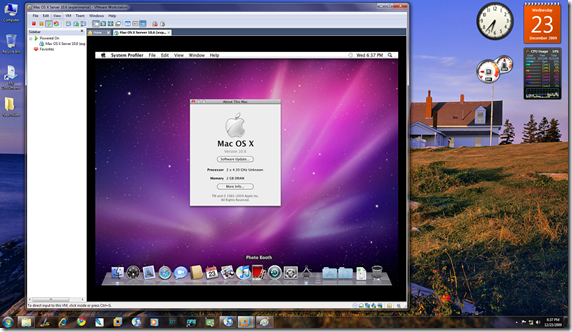


VMWARE 7 FOR MAC MAC OS X
$ sudo cp -R “/ Volumes / Mac OS X Install ESD / Packages” / Volumes / MyInstaller / System / Installation / Packages $ sudo rm / Volumes / MyInstaller / System / Installation / Packages Make sure that the boot file contains at least the following key / value so that you can specify the location of the kernelcache file,īefore packages can be copied from an Lion installer image, there is a file in the installer image that must be deleted. $ cd / Volumes / MyInstaller / Library / Preferences / SystemConfiguration / $ sudo vi $ cp “/ Volumes / Mac OS X Install ESD / kernelcache” / Volumes / MyInstaller / kernelcache I’ll rename mine back to MyInstaller.įirst, the file must be copied from the Lion installer image to the installer image, then the boot configuration file must be updated to determine the location of the file. Note that if you selected “Remove Target,” your installer image now has the same name as the “Mac OS X Base System” source. When this is done, you can delete the BaseSystem image, it is no longer needed. The ‘Restore’ feature of Disk Utility works well for this. The entire contents of the base system must be copied to the installer image. Volume is installed as ‘Mac OS X Base System’ $ cd “/ Volumes / Mac OS X Install ESD” $ open BaseSystem.dmg One of these hidden files is BaseSystem.dmg, which is used to boot the system. The Lion installer contains a number of hidden files, and to access them, you must run Terminal. If yours is attached to something different, you will need to make the necessary changes to match it in the following steps. The image I received is attached as ‘Mac OS X Install ESD’. Step 2: Install the Lion installer image. Name: MyInstaller Size: 5GB Format: Mac OS X Advanced Encryption: None Partitions: Single Partition – Apple Sitemap Image Format: DVD / CD Host You can name it however you like, but be sure to change the steps below accordingly. Use Disk Utility to create and install a new image with the following settings: Not as easy as the first hurdle, but still possible. Or just downright hostile and tell you, “Not here, Jack!” But as it turns out, there is also a workaround. Issue The Lions installation and startup process is much different, and the virtual machine doesn’t know what to do with it – booting from a disk image turns a corner of the virtual machine into a corner and screams for help. It seems that the system only checks for the existence of one file that can be created to calm the VM gods.


Number Only server versions of Mac OS X can be used on a virtual machine. Who knows what crazy things can happen? Sucks if there was something wrong with the file system (or installed virus) and it erased all attached drives !!! So, since I already use VMware Fusion for my OpenBSD web server, why not run Lion on a virtual machine !? Jee! The OS X Lion Developer Edition is out! I’m not going to say where I got it, but I have it and I want to play with it!īut … Since I have been ill and I have a beta version, I really do not want to install it on the hard disk and start iMacini it. Update: appears to have disappeared from the earth’s surface, here is a repeat of the crawl below through Google’s cache:Īll ready? Then take a look at ObvyLogic’s great walkthrough: By installing Lion on VMware, it’s divided into 12 easy-to-follow steps.
VMWARE 7 FOR MAC UPGRADE
If you’re curious, you can read my review of the 8GB RAM upgrade for the MacBook Pro, where I’ll detail the benefits of getting multiple memories. How cheap RAM these days I consider it a necessary upgrade for power users. In terms of RAM requirement, VMware and virtual machines usually work best when using a lot of RAM, if you plan to use them frequently on your Mac, it is highly recommended that you upgrade to 8GB. In any case, if you want to try out a Lion on a virtual machine, you need the following: Using a dedicated partition will eventually work better and the installation process will be much easier than setting this up to work in VMware. If you’re serious about Lion development, keep in mind that virtual machines have limitations, and you should probably just configure your own partition to run a developer preview. This is really only recommended for more technically inclined Mac OS X users. If you want to use Mac OS X 10.7 Lion Developer Preview, but don’t want to bother setting up another partition or updating your current Mac OS X 10.6 installation, you can choose the third option: Run Lion on a virtual machine with VMWare.


 0 kommentar(er)
0 kommentar(er)
